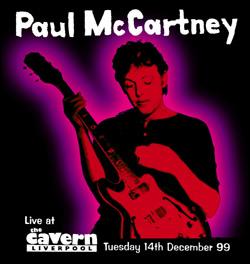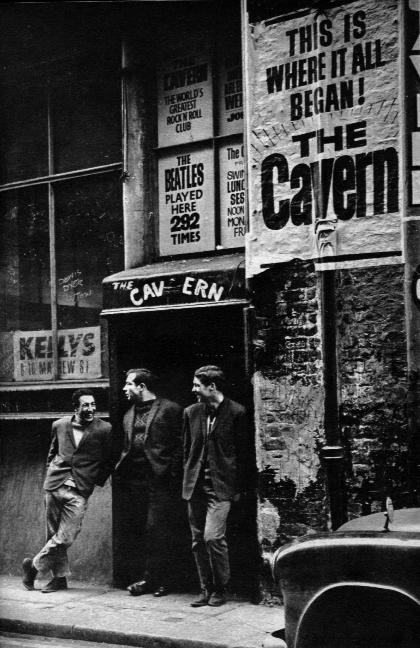
Photo, front entrance to the original Cavern, early 60s.
Gerry Marsden of "Gerry and The Pacemakers" describes The
Cavern:
"The Cavern had an atmosphere, right enough, for the fans. It
stank of disinfectant and stale onions. It was hot, sweaty and oppressive. Blair
Hall was ten times better, Holyoake Hall in Penny Lane was brilliant with a big
beautiful big stage and a dance floor the kids could enjoy. All the bands
preferred it to the Cavern. If Brian Epstein had gone to any of these places to
discover us and the Beatles, these venues would have been famous. But the Cavern
went down in history."
**1957**
WEDNESDAY 16 JANUARY
The Cavern Club opens.
To add variety to the club so that it wouldn't strictly be a jazz venue in Liverpool, Sytner decides to designate each Wednesday as "Skiffle Night" while Thursday would stage "modern jazz". The weekend evenings would be reserved for the more "traditional jazz".
SATURDAY 3 OCTOBER
Ray McFall takes control of the Cavern Club -- jazz policy maintained.
Cavern Club owner Alan Sytner steps down and gives control of the venue to Ray McFall. The exchange of management saw no change in the weekly jazz format (for several months) since the club had built up a very impressive artistry of jazz musicians. These musicians would continue to play for a while until "Skiffle" and then later, "Rock 'n' Roll" would force them out of the Cavern. But for now, these are the jazz musicians who continued to play at the Cavern: Alex Welsh, Tubby Hays, Tony Kinsey, Bob Wallis, Micky Ashman, Kenny Baker, Cy Laurie, Humphrey Lyttelton, Terry Lightfoot, Ronnie Scott, Nat Gonella, George Chisholm, Ken Colyer and The Clyde Valley Stompers. The new owner's opening session comprised of Mr. Acker Bilk's Paramount Jazz Band; Sonny Terry and Brownie McGhee.

Acker Bilk
Brief biography on "Acker Bilk": He was born Bernard Stanley Bilk on January 28, 1929 in Pensford, Somerset, England. He first found success as a clarinetist in Ken Colyer's band in 1954. By 1958, Acker formed the Paramount Jazz Band. He had his first British top ten hit "Summer Set" just over a year later. He followed with two more top ten songs, "Buona Sera" and "That's My Home." In 1962 Acker Bilk went to #1 with "Stranger On The Shore".
SUNDAY 10 JANUARY
First night of Liverpool's first ever Jazz Festival at The Cavern
The Cavern presents Liverpool's first ever "jazz festival" organized to last an entire week of evening entertainment. The club opened the first night starting with Mr. Acker Bilk's Paramount Jazz Band. The remainder of the weeks schedule had performances from Terry Lightfoot's New Orleans Jazzmen, Alex Welsh and his Band, Johnny Duncan and the Blue Grass Boys, Ken Coyler's Jazzmen and Mickey Ashman's Band.
The Cavern Holds It's First Beat Night
Spencer Leigh and Pete Frame, authors of "Lets Go Down The Cavern" writes: "The jazz festival was not a success and the club sustained a loss of £3000 in Ray McFall's first year. Ray had noticed that rock'n'roll nights were popular in the suburbs but there was no outlet in the city center. So, on 25 May 1960 the Cavern held its first beat night, featuring Cass and the Cassanovas (who later became the Big Three) and Rory Storm and the Hurricanes. It attracted a new audience and its success led to a complete change in policy at the Cavern. Nevertheless, the club still had an enormous queue for the then highly popular trad[itional] jazz band, the Temperance Seven." Meanwhile, the Quarry Men who by now have long since renamed themselves as "Silver Beetles" play St. Thomas' Hall in Keith, Banffshire on this date.
Wump and the Werbles perform.
The club continued to book various bands. On this date, Wump and the Werbles are top of the bill at the club for £5! John Cochrane drummer for Wump and the Werbles, recalls, "The first time we played the Cavern we were terrified because it had a reputation that if the audience didn't like you, you got pulled apart. The groups had to leave through the front entrance and so if you hadn't gone down very well, you had to hide at the back until everyone had gone."
The Remo Four make their debut.
The Remo Four combo makes their debut at the Cavern Club on this date. The band's basic musical origin came from skiffle, but later they patterned their musical style around the instrumental hits of the Shadows and the Ventures. Their two singles on the Piccadilly label were: "Wish I Could Shimmy Like My Sister Kate" (1964); "Sally Go Round The Roses" (1964).
Though the club hires more beat groups, the clubs jazz policy for Thursday to Sunday evenings still followed at this time.
Gerry and The Pacemakers make their debut.
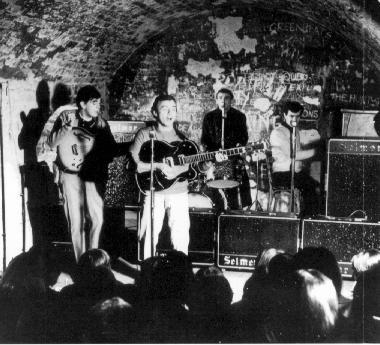
Gerry and The Pacemakers debut at the Cavern as a supporting attraction. Gerry, recalling how difficult it was passing through the Cavern said: "It was nightmare to get in and out of; struggling down the stairs from Mathew Street to the cellar with all our gear was tough, but it was the only entrance because there was no backstage....I shudder to think of the effect of a fire down there, had there ever been one."
Lunchtime "beat sessions" introduced.
Cavern club decides to open its doors to lunchtime beat sessions which would normally run from 12:00 - 2:00 p.m.
Cass and the Cassanovas topped the bill.
Cass and the Cassanovas topped the bill with Emile Ford and Gerry and the Pacemakers in support.
John Barry Seven make guest appearance.
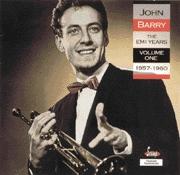
The John Barry Seven was an instrumental group. The sounds they produced were a combination of Dixieland and mood music. Later, John Barry's music career found himself involved in scoring music for films -- his most memorable piece was the James Bond Theme in the first 007 film, "Dr. No." Vic Flick, guitarist from the John Barry Seven was responsible for that unique guitar sound contained in the opening Bond Theme. The musical score, not surprisingly, has been used in every Bond movie ever since! John Barry has won Academy Awards for "Best Musical Score, Original Score" for "Dances with Wolves" and "The Lion In Winter"; he has also won the British Academy Award for "Best Original Film Music" in "The Lion In Winter"; he has received two Grammy Awards for "Best Instrumental Theme" for "Midnight Cowboy"; a Grammy Award for "Best Instrumental Composition, Motion Picture/TV" for "Dances With The Wolfs." Mr. Barry has never won a musical award for his work on the James Bond movies. John Barry hails from York, England, and was born on November 3, 1933.
WEDNESDAY 18 JANUARY
The Shadows make a guest appearance.
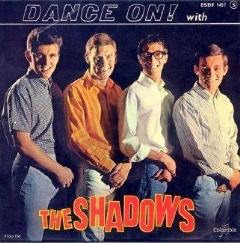
The Shadows are considered England's hottest instrumental acts from the '60s.
The genesis for the group began with Hank Marvin and Bruce Welch, both sixteen-year-olds living in Newcastle, decided in 1958 to become part of the group "The Railroaders". The group entered a talent contest in London and won third place (behind a jazz band and opera singer). After the contest was over, the band split up with Hank and Bruce staying in London to seek out further fortunes while the remaining members of "The Railroaders" returned home. Meanwhile, another musician was enjoying some success with a debut single called "Move It". The stars name was "Cliff Richard" and he was billed on a tour with famous American stars "The Kalin Twins". Cliff's manager needed a lead guitarist for the backing group "The Drifters" so he checked out the 2I's coffee bar in Soho, thinking that Tony Sheridan might be a good for the job. Instead, Cliff Richard's manager ended up signing Hank Marvin and Bruce Welsch for the tour.
A musician by the name of Jet Harris was also on the tour with the Most Brothers. He was eventually given replacement duty for Drifters bass guitarist Ian Samwell (during the Shadows career, Jet Harris would later be replaced by Brian Locking, who performed in another group called "Marty Wilde's Wild Cats and Krew Cats").
Moving forward, in 1959, drummer Terry Smart left and was replaced by Tony Meehan (who was also replaced in 1961 by drummer Brian Bennett, another band member from "Marty Wilde's Wild Cats and Krew Cats".) The group released "Feelin' Fine" under the name "The Drifters" but the American group, "The Drifters" sought a court injunction and won in preventing the British group from using their name. The group made a few name changes, the first one being "The Four Jets" before finally going with "The Shadows." And of course, the band has released several titles under the guise of "Cliff Richard And The Shadows" when played as back-up to Cliff's recording sessions.
The band enjoyed a total of 5 U.K. number hit singles: "Apache" (1960);
"Kon-Tiki (1961); "Wonderful Land" (1962); "Dance On" (1962); "Foot Tapper"
(1963).
Kingsize Taylor and the Dominoes debut.
Kingsize Taylor musical career would see him record a total of six singles -- enough to fill an album! Kingsize Taylor also appeared on a few of the tracks from "The Beatles Live In Hamburg" on Lingasong Records.
Singles recorded by Kingsize Taylor and the Dominoes on Polydor and Decca labels respectively: "Money (That's What I Want)" (1963); "Whole Lotta Lovin' " (1963); "Memphis Tennessee" (1964); "Hippy Hippy Shake" (1964); "Stupidity" (1964); "Somebody's Always Trying" (1964).
Also appearing as special guest at the Cavern is "Swinging Cillia" (songstress Cilla Black).
Kenny Ball's Jazzmen make an appearance.

Though the Jazzmen were just newly formed just a few months before, on June 24, 1959, Kenny and his musicians recorded three tracks (two of them being skiffle tracks) for the small independent label, Collector. The songs "Black Bottom Stomp", "Baby Doll", and "Hiawatha Rag" were recorded but not in what might be considered as ideal commercial studio conditions in those days. Nonetheless, the songs were issued by Collector.
The Cavern opens evening sessions.
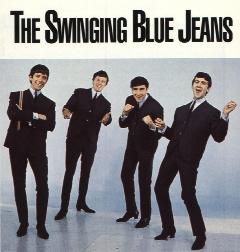
Cavern owner decides to hold "Guest Night" which was hosted by The Bluegenes. When the Cavern's musical policy changed to rock'n'roll, the Bluegenes changed with it. The groups musical style was originally "skiffle". Ray Ennis recalls: "We started as a relief band at the Cavern Club. The club's musical policy at the time was jazz, and we went on while the jazz boys took a break and went out for a pint. Bob Wooler, the Cavern disc jockey, described our style as 'sophisticated skiffle.'" The Tuesday night residency included guest spot appearances for visiting bands, which included The Beatles first appearance on March 21, 1961.
Originally called "The Bluegenes Skiffle Group" the band would go through a few more name changes and in 1963, they would eventually settle on "The Swinging Blue Jeans". The group's line-up consisted of Ralph Ellis (guitar); Norman Kuhlke (drummer); Ray Ennis (guitar); and Les Braid (bass guitar). The band's first single release would be "It's Too Late Now" (1963), which was a minor hit but their third release, "Hippy Hippy Shake" (1963) took the band into a Top 3 position on the music charts. The group had two more major hits in 1964 with "Good Golly Miss Molly" (1964) and a R-&-B number called "You're No Good" (1964).
On this date, the Beatles play the Cavern at a "Lunchtime" appearance and would also show up at the Cassanova Club and the Litherland Town Hall.
The Four Jays make their Cavern debut.
The Four Jays make their Cavern debut. The band would later rename themselves as "The Fourmost". Later, this group would have their first two singles on Parlophone penned by Lennon/McCartney: "Hello Little Girl" (1963) and "I'm In Love" (1963).
The Johnny Dankworth Band.
The Beatles, as guests, make their "Night-time" debut at the Cavern. The Bluegenes become regular Tuesday hosts for the club.

JOHN LENNON (on those early days at the club): "We came across our first snobs in the music scene by people that prevented us [from] playing in competitions and things because we played rock'n'roll and not skiffle -- not anything skiffle, that's where we first came across it. And they had big, vast, skiffle competitions -- now all those sort of people who have those talent shows, you know, where they have the talent show running for five years and they get free people, people working for them free for five years and hope they would win. And we went into every one locally and we'd always be winning, you know, us and someone else's group be just coming to the finals and then we'd get banned for singing "Blue Suede Shoes" you know, or whatever it was, and that was the first snobbery in music we came across.
"On the Cavern, amazingly enough, there used to be a big jazz place. We were allowed to play there graciously by the governors who weren't the same governors who worked with us later. And they've kept sending notes up to stop singing rock'n'roll -- sing skiffle, you know. And we'd announce "Blue Suede Shoes" by Leadbelly and that great old skiffle song called "A Whole Lot of Shaking" and things like that, and they kept sending up notes and then we were banned from the Cavern for a year after that."
Quoted from "Pop Goes The Bulldog" -- an interview straight on the heels of his Toronto Peace Festival performance of September 13, 1969, which was originally aired in December, 1969.
Johnny Sandon and The Searchers make their debut at the Cavern
The Searchers were formed in 1960 by Chris Curtis (drums) along with Mike Pender (lead guitarist); Tony Jackson (vocals, bass guitarist); and John McNally (rhythm guitar). They would, for a while, back Liverpool singer Johnny Sandon while performing at the Cavern. The band would later drop Sandon and in 1962, the band sent in a demo tape to PYE's A-&-R representative Tony Hatch. A year later and the band signed a contract with PYE records.
The Searchers, who's name originated from a John Ford western movie, would later topple the British charts with "Sweet For My Sweets" (1963), the band first single which was written by "Doc Pomus/Mort Shuman". The debut single went to No. 1 position. "Meet The Searchers" LP was quickly issued and highlighted such standards as "Love Potion Number 9" and "Farmer John". The groups single "Sugar And Spice", a composition by Tony Hatch, just failed to make the No. 1 spot. But the groups third single, "Needle and Pins" (1964) composed by "Jack Nitzsche/Sonny Bono" won them international acclaim. Things started to go somewhat awry for the group: the pop world was shocked by the abrupt departure of bass player Tony Jackson who provided much of the groups identity by use of his falsetto vocals. He was replaced by Frank Allen (from "Cliff Bennett And The Rebel Rousers"). The band moved towards a more folk-rock style of music and released "What Have They Done To The Rain" that resulted only in a lower chart placing. They decided to make an attempt to recapture the old Searchers sound and released "Goodbye My Love", and while it did enter the U.K. Top 5 in early 1965, it clearly indicated that the band's number 1 days were finished.
Kenny Ball's Jazzmen appear at the Cavern Club.
On this date, Kenny Ball's Jazzmen are supported by Gerry and the Pacemakers. Weekend bill-toppers still traditional jazz attractions with beat groups creeping in lower down the list!
Big Welcome Home session for the Beatles following their second trip to Hamburg.
For this performance, Johnny Sandon and the Searchers are also on the same bill -- but the whole evening theoretically topped by the White Eagles Jazz Band!
The Bluegenes appear in their usual Tuesday time slot.
Guests for the show: the Beatles, Gerry and the Pacemakers and the Remo Four.
The Beatles, Gerry and the Pacemakers, Johnny Sandon and the Searchers and The Four Jays all appear on one bill!
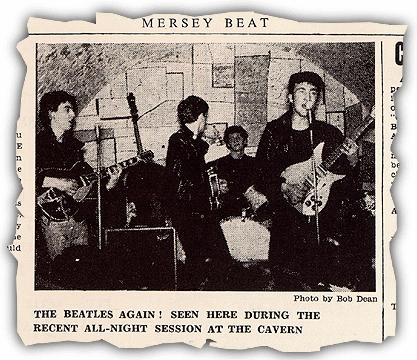
The Beatles appear at the Cavern Club.
Wednesday evening residency for The Beatles is established with The Bluegenes who are still hosting Tuesday sessions.
The Beatles appear at the Cavern Club.
The Beatles as interval attraction on a traditional jazz bill.
Brian Epstein goes to the Cavern.
Brian Epstein goes to the Cavern and watches the Beatles perform a lunchtime session.
Bob Wooler (recalling Epstein's first visit to a Beatles performance): "...he phoned Bill Harry at Mersey Beat and he wanted his entrance smoothed into the Cavern. He took Alistar Taylor with him for support. Bill Harry arranged it with Ray McFall and Pat Delaney on the door and Brian stood in the back of the crowd and saw these four people on the stage. Brian knew about "My Bonnie" and he discovered that the Beatles were playing close to his shop in Whitechapel. He was intrigued to see what they were like and from the moment he came, he was conquered by them. He didn't rush in on it, though, there was a getting-to-know-you period. He went to one or two venues to see what they were like and how they behaved, and he found their behavior quite animalistic." Brian would soon sign The Beatles to a management contract and helped the group in securing a record company (EMI-Parlophone) for them.
Brian Epstein: "It was pretty much an eye-opener, to go down this darkened, dank, smoky cellar in the middle of the day, and to see crowds and crowds of kids watching these four young men on stage."
Final Thursday Modern Jazz Session.
Appearing for this final modern jazz session starred Tony Kinsey Quintet.
The Beatles appear at the Cavern Club.
Not only the Beatles, but also Gerry and the Pacemakers, Johnny Sandon and the Searchers joined jazz bands for this all-night session.
FRIDAY 2 FEBRUARY
Pete Maclaine and the Dakotas debut at the Cavern!
The band is the first Manchester outfit to play the club.
The Beatles and Gerry and the Pacemakers appear at the Cavern.
Billed as top act, Saints Jazz Band performs at the club with the Beatles and Gerry and the Pacemakers as supporting attractions.
The Beatles perform at the Cavern.
Other acts included Gerry and the Pacemakers plus Johnny Sandon and the Searchers.
The Merseybeats make their Cavern debut!
Original members of the Merseybeats comprised of Tony Crane (lead guitar/vocals); Aaron Williams (rhythm guitar/vocals); Billy Kinsley (bass guitar/vocals) and John Banks (drums). Formation of the group began in 1961 as "The Mavericks". The band decided to drop the name as it was felt that it sounded too "country" of a name for a pop group, so, for a brief time, they called themselves "The Pacifics". By early 1962 they finally went with "The Merseybeats". In 1963 they established themselves on the "Fontana" record label with their first release, "It's Love That Really Counts" (1963), a cover version taken from The Shirelles. With record sales of 100,000 copies from that first disc, Fontana decided to release the band's next single entitled "I Think I Love You" (1964), another big hit that made it into the top five.
The Beatles Fan Club Night!
This is the first Thursday opening since the end of Modern Jazz sessions. Beatles open with the Four Jays in support.
The Saints Jazz Band and the Beatles play the Cavern.
The Beatles played a two-hour mid-evening spot between first and second traditional segments by the Saints Jazz Band.
The Dennisons make their Cavern debut!
The Bluegenes have the Dennisons (Liverpool's youngest group) on their "Guest Night" making a debut appearance. Johnny Sandon and the Searchers also featured.
Farewell session for Gerry and the Pacemakers.
The Cavern organizes a farewell session for Gerry and the Pacemakers prior to their Hamburg trip.
Johnny Kid and the Pirates perform at the Cavern club.
First of four consecutive appearances by the first Southern group to visit the Cavern, Johnny Kid and the Pirates!
Mike Berry and the Outlaws perform at the Cavern club.
First of five nightly appearances by Mike Berry and the Outlaws.
Planned "Welcome Home" session for the Beatles.
On this date, the Cavern had originally planned as a "Welcome Home" happening for the Beatles return from Hamburg. Instead, John Lennon, Paul McCartney, George Harrison and Pete Best head off to London to audition for Parlophone Records, a record company known for Scottish dance records and comedy albums. Filling in for the Beatles were the Big Three. Three days later, the Cavern would provide a belated "Welcome Home" session for the group.
Pete Best: 'We went off to Germany in April to open the Star-Club while Brian took a tape of the Decca auditions round the recording companies in London trying to get us a contract. In May we received a telegram from Brian saying "Congratulations. You've got a recording session with EMI. Write your own material." That was when they wrote "Love Me Do". We came back and auditioned for George Martin at EMI. He liked "Love Me Do" and said, "Fine. Go away and rehearse a bit more. Then come back and we'll put the finishing touches to it." Between those recording dates, in August 1962, I got kicked out.'
Belated "Welcome Home" session for The Beatles!
"Bruce Channel", first American to appear at the Cavern Club!
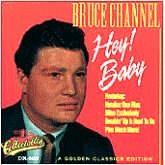
Bruce was born, 1940, in Jacksonville, Texas. His music career began as a teenager with performances that went round Texas until joining a radio program called the "Louisiana Hayride" in 1958. In 1961, he went to Fort Worth, Texas, to record some songs, one of them being "Hey! Baby". The musician who played harmonica on that recording, is a fellow by the name of "Delbert McClinton". In 1962, "Hey! Baby" became a No. 1 song for Channel and so he and Delbert commenced with a tour in England. During their visit, harmonica player Delbert McClinton ran into John Lennon. The two of them got along well together and so they discussed harmonica playing, which was something of a curiosity to John Lennon. Bruce Channel, who was interviewed by Spencer Leigh for the BBC Radio Merseyside in April, 1998, recalls:
"Paul's brother, Michael McCartney, did a book of photographs and a picture he took that night is in there. I remember meeting the Beatles but it seems to me that I was talking to press people and other folks. Delbert told me that he had been in the dressing room with John Lennon who was very interested in his harp, so Delbert played something for him, and evidently John kept the idea and used it for the sound of Love Me Do. You're glad when anybody likes your music but especially someone of that stature. It's a great thrill. We had heard the harmonica a lot on blues records by Jimmy Redd and people like that."
In 1968, Bruce Channel had an international hit called "Keep On".
First Sunday to be completely minus jazz content!
Performing acts on this date were: the Beatles, the Bluegenes, Gene Vincent and Sounds Incorporated.
Freddie and the Dreamers make their Cavern debut!
The Bluegenes have as their guests, not only Freddie and the Dreamers but also Johnny Sandon and the Searchers.
Band line-up for Freddie and the Dreamers: Pete Birrell (bass guitar); Roy Crewsdon (guitar); Freddie Garrity (vocalist); Derek Quinn (lead guitar); Bernie Dwyer (drums). Freddie and the Dreamers were known as a humorous act with extreme choreography. The ex-milkman Freddie Garrity explains: "We've always been daft. I mean you couldn't call me a sex-idol, could you?" The band was the first group to score with a R-&-B revival hit with "If You Gotta Make A Fool of Somebody". In 1965 the band released "I'm Telling You Now" which hit the top US charts and the group managed a U.K. Top 3 single with "You Were Made For Me." By 1966, the group was no longer charting in the U.S. and hits were far and few in between on the U.K scene. In 1968, the group disbanded.
Billy Kramer and the Coasters make their Cavern debut!
Billy Kramer and the Coasters debut on bill topped by guest artists Jimmy Justice.
Joe Brown and the Bruvvers appear at the club.
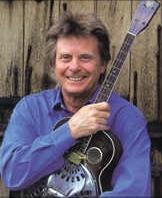
Joe Brown was born on May 13, 1941, Swarby, Lincolnshire, England. He formed his own group, "Joe Brown and the Bruvvers" in 1960. The band released the following singles: "Darktown Strutters Ball" (1960); "What a Crazy World We're Living In" (1962); "A Picture of You" (1962); "Your Tender Look" (1962); "It Only Took a Minute" (1962); "That's What Love Will Do" (1963); "Nature's Time For Love" (1963); "Sally Ann" (1963) and "Picture of You" (1962) became his No. 1 hit! Joe Brown would record "Henry The Eighth I Am", a song recorded four years before another British act - "Herman's Hermits" -- would make it into a top hit contender. Joe's early professional music career included his playing guitar for Johnny Cash, Gene Vincent, Eddie Cochran, Jerry Lee Lewis, Little Richard and Chuck Berry. Brian Epstein promoted Joe's shows in the North West of England, who sometimes would provide a few opening slots for the Beatles.
Sunday jazz set continues its downward trend in popularity!
Traditional jazz fading toward foot of weekend bills. Mark Peters and the Cyclones plus Lee Curtis and the All-Stars topped over the Saints Jazz Band.
The Beatles at the Cavern club!
Gerry and the Pacemakers along with the Merseybeats co-starred at this session.
Gerry Levene and the Avengers make Cavern appearance.
The Bluegenes, continuing as Tuesday evening hosts at the Cavern, featured the Beatles plus their first Birmingham group to play the Cavern: Gerry Levene and the Avengers.
Bluegenes leave for Hamburg.
The Bluegenes left for Hamburg and ended a long sequence of Tuesday guest sessions. Billy Kramer with the Coasters featured instead.
Meanwhile, the Beatles record their first songs: "LOVE ME DO" and "HOW DO YOU DO IT" for the EMI/Parlophone label.
The Dennisons appear at the Cavern club.
The Beatles unable to make usual Wednesday appearance due to first recording session in London, thus the Dennisons stood in for them. The Dennisons comprised of "Eddy Parry" (vocals); "Ray Scragg" (rhythm guitar/vocals); "Steve McLaren" (lead guitar); "Allan Willis" who quit the band for his apprenticeship and was then replaced by "Terry Carson" (bass player). The band formed in 1961; was musically influenced by a local band called the Ravens (who later became "Faron's Flamingos"). In 1963, Decca records signed them to a recording contract. The groups first single "Come On Be My Girl" (1963), a number they had written, achieved minor success peaking at No. 46 on the U.K. charts. Their next release "Walkin' The Dog" (1964) achieved just a little better result, peaking at No.36. With the lackluster success, the band was offered "All My Loving", a Lennon-McCartney composition, but turned it down. In the summer of 1964, the group released "Nobody Like My Baby" but it failed to scale the charts. In 1967, the group disbanded.
Gerry and the Pacemakers appear at the Cavern club.
Featured with Gerry and the Pacemakers are the Big Three along with the Merseybeats.
The Beatles, Billy Kramer with the Coasters appear at the Cavern club.
Guest artist Clinton Ford is featured on the bill.
Return of Joe Brown and the Bruvvers.
The group appears twice: for a lunchtime and evening session at the club. Appearing on the evening bill were Gerry and the Pacemakers and the Merseybeats.
Return of Freddie and the Dreamers for lunchtime and evening sessions.
The evening bill also included the Beatles and London songstress Simone Jackson who sang with them.
Gerry and the Pacemakers appear at the Cavern club.
Gerry Marsden on the music scene: "There are about 170 groups playing clubs and dance halls, and there used to be more. Fans in Liverpool like their music wild, and it's they who are responsible for this Scouse R-&-B sound everybody is talking about. We always considered London to be a little village outside of Liverpool. In the South, I think the groups have let themselves get a bit formal, unlike on Merseyside where it's beat, beat all the way -- we really have a ball on stage."
Farewell session for Gerry and the Pacemakers before departing to Hamburg.
Debut of The Undertakers at the Cavern.
The Undertakers were formed in 1961, in Wallasey, Merseyside. The band's original line-up comprised of Jimmy McManus (vocals); Chris Huston (lead guitar); Geoff Nugent (guitar/vocals); Brian "Boots" Jones (saxophone/vocals); Dave "Mushy" Cooper (bass guitar); and Bob Evans (drums). The Undertakers saw a change in the band line-up 18 months later with Jackie Lomax (bass/vocals) and Bugs Pemberton (drums) replacing Dave Cooper and Bob Evans.
The band were initially called the "Vegas Five" but took on their new name when a printing error occurred in a newspaper advertisement. Brian Jones of the Undertakers recalls how the name 'The Undertakers' came about: "We were playing at the Aintree Institute and we looked to see if we were listed. The name "Undertaker" was advertised for the Aintree Institute and then we found the name Vegas Five in the "Deaths" column. We phoned Bob Wooler and he said, "You might as well be called the Undertakers." We learned "The Dead March" in the dressing room before we went on."
The Undertakers released four singles between 1963 and 1964 and were on the PYE label but was only adequate for the marketplace with songs such as "Everybody's Loves A Lover" (1963) (an old Shirelles number); "What About Us?" (1963); "Just A Little Bit" (1964) and "If You Don't Come Back" (1964).
The band is best remembered more for their live performances where they visually presented themselves bedecked in black frock coats coupled by the R-&-B sound with saxophone. The band shortened their name to "Takers" in an attempt to freshen up their image but proved unsuccessful where the Hit Parade was concerned.
The Beatles (one week after the release of their first record) with Little Richard appear at Cavern.
Johnny Sandon and the Remo Four
The Searchers went to Hamburg without Johnny Sandon who appear for the first time in front of the Remo Four.
American act B. Bumble and the Stingers top the bill.
Also, first appearance of the Four Jays under their name, the Fourmost. Billy Kramer and the Coaster also hold a session on this date.
Debut of Tommy Quickly and the Challengers.
The Big Three final appearance before leaving for Hamburg sessions.
Formed in Liverpool in 1961 as an offshoot from Cass And The Cassanovas, the Big Three comprised John Gustafson (vocals/bass), Johnny Hutchinson (vocals/drums) and Adrian Barber (guitar). During 1962, Barber relocated to Germany and was replaced by Brian Griffiths, who had his debut at the Star Club, Hamburg.
Moving forward, by November 1963, Griffiths and Gustafson found alternative employment with the Seniors; Hutchinson recruited Paddy Chambers and Faron (of the Flamingos) as replacements. Less than a year later, the Big Three disbanded. Gustafson later joined the Merseybeats and several more groups after that.
The Beatles at the Cavern!
Back from Hamburg, Gerry and the Pacemakers also share the bill with the Beatles.
The Beatles at the Cavern!
This would be the last session during the Christmas season before leaving for Hamburg. Gerry and the Pacemakers took over their Wednesday and Sunday spots.
The Tornados appear at the club.
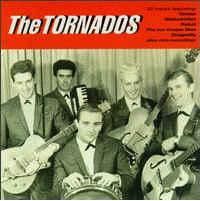
First of two consecutive lunchtime sessions for the band.
WEDNESDAY 2 JANUARY
Billy Kramer with the Coasters, last appearance.
Final appearance of Billy Kramer with the Coasters before he turned professional and began to work with Manchester's Dakotas. The Dennisons plus Johnny Sandon and the Remo Four on the same bill.
Gerry and the Pacemakers with the Fourmost
Guest appearance from Susan Maughan, included on the bill.
The Beatles at the Cavern!
Also featured for sessions were the Dennisons, the Merseybeats and Swinging Bluegenes.
The Swinging Bluegenes at the club.
Appearing also are the Merseybeats with guests the Marauders.
The Hollies make their debut!
&
First "Rhythm & Blues Marathon" at the Cavern Club!
Featured the Beatles, the Merseybeats, the Fourmost, the Swinging Bluegenes and Kingsize Taylor and the Dominoes and of course, the Hollies.
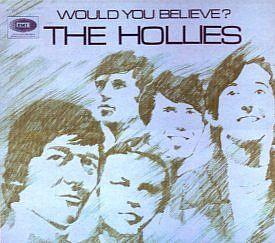
The Hollies comprised of Allan Clark, Bernie Calvert, Graham Nash (who was later replaced by "Swinging Blue Jean", Terry Sylvester") Bobby Elliot and Tony Hicks. The groups first single on Parlophone was an old American R-&-B cover version taken from the Coasters entitled ("Ain't That) Just Like Me" (1963). The Hollies first UK Top 20 was "Searchin" (1963), another Coasters number they recorded. Later the band released "Just One Look" (1964), which made its debut at No. 3 spot (the song "Just One Look" was recorded previously by Doris Troy where it was a big hit in America.) The band continued hits success with "Bus Stop" (1966); "Stop! Stop! Stop!" (1966); "On A Carousel" (1967); "Carrie Anne" (1967); "King Midas In Reverse" (1967); "He Ain't Heavy, He's My Brother" (1969); and their big classic hit: "Long Cool Woman In A Black Dress" (1972).
Debut of the Nomads
The Nomads (who later became the Mojos) perform at the club along with the Dennisons, Freddie Starr and the Midnighters and Tommy Quickly and the Challengers.
Gerry and The Pacemakers at the Cavern!
This performance occurs just after the band had released their first record.
Billy J. Kramer with the Dakotas appear for lunchtime and evening sessions at the Cavern.
Billy J. Kramer (real name: William Howard Ashton), hailed from Bootle, Lancashire. He first came to the attention of Brian Epstein while Billy was still performing with the "Coasters". Because Billy is a very photogenic pop star, Brian Epstein decided to use Billy for the Dakotas line-up to replace Pete Maclaine. This occurred during February, 1963. The groups first chart topper was a "Lennon-McCartney" song called "Do You Want To Know A Secret" (1963). Billy recalls, "Lennon-McCartney wrote my first single for me some time before I recorded it, and I have a slower version of it in the stage act for quite some time." The band's next release, "Bad To Me" (1963) -- another Lennon-McCartney original, went straight to No. 1 spot. The band last major hit was "Little Children" which was composed by Mort Shuman, an American songwriter. The band continued on in the recording industry up until 1968 before calling it quits.
Gerry and the Pacemakers lunchtime session!
Evening stars were the Searchers, the Fourmost and the Merseybeats.
Guest appearance of the Karl Denver Trio
Featured supporting acts were the Big Three and the Hollies.
The Karl Denver Trio were noted for the following songs "Marcheta" (1961); "Mexicali Rose" (1961); "Wimoweh" (1962); and "Never Goodbye" (1962).
The Bachelors at the Cavern, evening sessions!
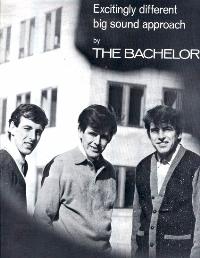
Singles recorded by the Bachelors: "Charmaine" (1963); "Faraway Places" (1963); "Whispering" (1963); "I Believe" (1964); "Marie" (1965)
Lunchtime act at the Cavern were the Searchers.
The Beatles at the Cavern!
This Good Friday session starring the Beatles plus seven groups including the Dennisons, Faron's Flamingos and the Road Runners.
Rory Storm and the Hurricanes at the Cavern.
Return of early club favorite: Rory Storm and the Hurricanes minus their original drummer Ringo Starr!
Rory and his Hurricanes would only release two singles: "Dr. Feelgood" / "I Can Tell" (1963) on the Oriole label; and "America" / "Since You Broke My Heart" (1964) on Parlophone records.
Billy J. Kramer with the Dakotas make Cavern appearance.
Supporting acts were Billy's former backing group the Coasters plus the Swinging Bluegenes.
"Coach Parties" begin!
First of many coach parties from all over the country. Four loaded buses arrived from Sheffield.
Alexis Korner's Rhythm and Blues Incorporated
make an appearance at the club.
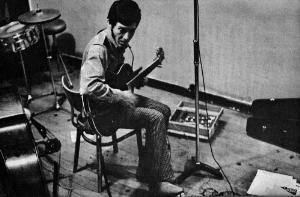
Alexis Korner made his mark in British music history for being the first to start up an English R-&-B group. The Times of London appropriately dubbed him as "the grandfather of British Rhythm-and-blues." His musical influence would touch future R-&-B groups such as the Rolling Stones, who in turn influenced R-&-B variations recorded by the Yardbirds.
Alex Korner was born in 1928, later joined the foreign service. Early training as a pianist led him to learning musical theory and harmony. Later, he eventually taught himself how to play guitar. Alex left the army in 1947 and joined the Chris Barber band for a year. After that, he formed his own band and recruited a trumpeter named Dickie Horden. Moving forward, in 1961, he returned to the Chris Barber band. The group opened in a small club in Ealing on St. Patrick's night in 1962. On May 3, they moved to the Marquee Club, London's most popular music club, filling the previously little-attended Thursday night spot. By mid-October they had become so popular that the Marquee's doors had to be closed by 8:30 p.m. because there was no more room inside. The band members at this point, consisted of Alexis Korner (guitar), Cyril Davies (harmonica), Mick Jagger (vocals), Dick Hextel-Smith (tenor saxophone), Keith Scott (piano), and Charlie Watts (drums). This was the beginning of what has become known as "The R-&-B Thing" in London.
Chick Graham makes an appearance the club!
Chick Graham with Billy J. Kramer's former combo the Coasters made enormous impact. Were to become Cavern favorites.
Steve Aldo with the Challengers perform at the club.
With Tommy Quickly going solo and fully professional, Steve Aldo replaces Tommy and appears with the Challengers.
Ketty Lester puts in an appearance at the Cavern.
Ketty appeared as special guest attraction with the Hollies. Her big hit was "Love Letters."
Pete Maclaine and the Clan perform at the Cavern.
After Pete left the Dakotas, Pete started up a new band. Decca records would later release the groups only single entitled "Yes I Do" / "U.S. Mail" (1963). Pete and the Clan were from Manchester.
Also making an appearance on this date at the Cavern, Gerry and the Pacemakers.
Debut of Wayne Fontana and the Mindbenders.
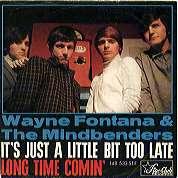
Wayne Fontana (born originally as "Glyn Ellis" in Manchester, England), was a lead singer for another group called the "Jets". Later, he auditioned for Fontana, a British record label, with the group called the Mindbenders. This band comprised of Wayne Fontana on (vocals); Eric Stewart (guitars, vocals); Bob Lang (bass); and Rick Rothwell (drums, vocals). The group had two minor U.K. hit discs with "Hello Josephine" peaking at No. 46, and "Stop, Look and Listen", peaking at No. 37. In 1964, the band had major success with a number called "Um, Um, Um, Um, Um", which placed No. 5 on the music charts. The Mindbenders biggest international hit was a song called "The Game of Love", which peaked at No. 2 on the U.K. charts.
The Cavern's "Bank Holiday Special".
FINAL APPEARANCE OF THE BEATLES AT THE CAVERN!
Other groups that performed on the "Bank Holiday Special": the Merseybeats, the Road Runners, Johnny Ringo and the Colts, the Escorts and the Sapphires.
Decca Recording Session At The Cavern!
Decca records an EP entitled "The Big Three At The Cavern" under the supervision of Liverpudlian recording manager Noel Walker.
The Nomads become the Mojo's.
To help celebrate their first disc release as the Mojo's, free-admission session was permitted to Cavern patrons.
Cavern Club Closes For This Night Only
On this date, the club is closed so that members could see BBC-tv programme "Tonight" which had been filmed at the Cavern.
First appearance of Tommy Quickly as solo singer!
Debut of the Germany's top group, "The Rattles".
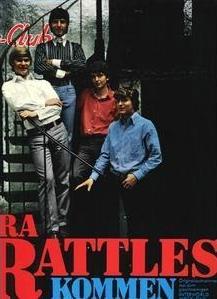
"The Rattles" were created in 1961 and were considered the best beat-group to come out of Germany. Melody Maker once wrote that the band was the "largest success since the Beatles in the Cavern Club, the German equivalent, The Rattles." They have been one of the acts to a Rolling Stones tour and in the summer of 1966, the Rattles accompanied the Beatles on their Germany route. The band's first big Top-20 hit on the German hit parade was a number called "La La La" (1965). They issued more singles: "Come On And Sing" (1966) and "Love Of My Life" (1966) and "Cauliflower" (1967). The success of this band was so popular that "Rattlemania" was coined by the German girls as equivalent to England's "Beatlemania". The band had appeared at the "Star Club" and has had also been recorded on the "Star Club" record label as well. The orignal members of the band starting in 1960 were: Achim Reichel (guitar/vocals); Herbert Hildebrand (bass guitar/vocals); Volker Rainhold (guitar/vocals); Dieter Sadlowski (drums). Between 1960 and 1962, Hajo Kreuzfeld replaced Volker Rainhold while "Dicky" Tarrach replaced drummer Dieter Sadlowski between 1962 to 1967. The Rattles saw 16 different incarnations of the band with many musicians coming and going between 1960 and 1976.
Other featured acts on this date at the Cavern were the Merseybeats and the Escorts.
Rolling Stones appear as special guests at the Cavern!

The genesis of the Stones is an interesting story to tell: Mick Jagger and Keith Richards both attended Dartford Maypole County Primary School when they were young and about a decade later, they both became strongly influenced by the "blues" and American "R-&-B". The influence, in particular, made Mick Jagger to team up with a fellow friend and musician named Dick Taylor. They formed a group called "Little Boy Blue and the Blue Boys". Eventually, Keith Richards would join this group.
Elsewhere in a town called Cheltenham, Brian Jones began to practice saxophone. But having fathered two illegitimate children by the time he was sixteen, forced Jones to leave town and head out to Scandinavia where he learned how to play guitar. He eventually drifted back to London where he would continue to develop his musical career with Alexis Korner Blues, Inc. Jones then decided to form his own band, a similar but looser version of Blues, Inc. The musicians for Brian's band would include Keith Richards, Mick Jaggar (as the front man for the band) and drummer Charlie Watts who eventually replaced Tony Chapman, another drummer the group had been working with. Chapman eventually left the band to persue other ambitions by attending Art College. But before he did that, he did manage to cut a demo tape with Jones, Richards, and Jagger which was rejected by EMI Records. By this time, Blues, Inc., had changed their name to the "Rolling Stones", after a Muddy Waters song.
The band formed in 1962. Their first show as "The Rolling Stones" occurred on July 12, 1962 at the Marquee. A few more line-up changes by January, 1963, saw Bill Wyman and Charlie Watts officially become members with the band. The Rolling Stones were eventually booked for eight months by Giorgio Gomelsky at the "Crawdaddy Club". It is here where Andrew Loog Oldham and Eric Easton saw the Rolling Stones perform. On April 29, 1963, a management deal was signed by Decca Records based on the observations made by Andrew Loog Oldham and Eric Easton when they saw the Stones the day before. Recording sessions were held at Olympic Studios on May, 10, 1963 where the group recorded and released their first single "Come On" (a Chuck Berry number) and "I Wanna Be Loved". The single peaked at No. 21 on the British charts. Their next recording, a Lennon-McCartney number entitled "I Wanna Be Your Man" was released on November 1 and peaked at No. 12 position on the British hit parade. The band continued that success by following with "Not Fade Away", released February 21, 1964, and reached No. 3 on the British charts. The month before -- January 6, to be exact -- they were top of the bill with the Ronnettes. It was during this performance that the group decided to go without there usual stage uniforms and presented themselves rather tacky in appearance. The establishment picked up on this and declared them as "long-haired louts". Thus the "Bad Boy's of Rock 'n' Roll" were born. They had more hits later with "Satisifaction"; "Get Off My Cloud", "Paint It Black" and the rest, as they say, is history.
The Rattles perform at the club.
First of twelve appearances of the Rattles during their 16-day tour organized by the Cavern Club.
Debut of The Liver Birds, an all-girl beat group.
WEDNESDAY 22 JANUARY
First ever Merseyside Festival for Rhythm and Blues purists at the Cavern.
Sonny Boy Williamson turns out to be the outstanding attraction at the festival.
Launching of the Junior Cavern Club.
Launching of the Junior Cavern Club with Saturday afternoon sessions for younger fans. Hundreds excluded after capacity crowd had been admitted. Personal appearance of Billy J. Kramer whose recording of "Little Children" had just been released.
Decca recording begins for "At The Cavern" Lp.
Decca's recording manager, Noel Walker, begins recording "At The Cavern" album with Heinz, Dave Berry and the Cruisers, Bern Elliot and the Fenmen, the Big Three, the Fortunes, Beryl Marsden, the Dennisons, Lee Curtis and the All-stars and the Marauders.
The Escorts, captured on film at the Cavern!
The Rank Organization Film company films "The Escorts" for the "Look at Life" series.
Oriole Records tapes Cavern sessions!.
John Schroeder, Oriole Records executive, supervises extensive recording sessions for the purpose of releasing two LP albums that features regular Cavern attractions.
Radio sessions recorded for series "Sunday Night At The Cavern."
Lunchtime and evening sessions for first programme in the Radio Luxembourg series "Sunday Night At The Cavern" compered Bob Wooler.
Jamacian songstress Millie Small makes special appearance at the club.
Millie's hit song "My Boy Lollipop" (words and music by Johnny Roberts and Morris Levey) had just entered the national charts.
Return visit of the Rattles from Hamburg, Germany.
The group now became one of Meseryside's most popular groups.
Having been a venue of some of the hottest acts ever to emerge from Liverpool, The Cavern Club closes its doors on March, 1973. The club is eventually destroyed.
APRIL
The Cavern Club Re-opens!
TUESDAY 14 DECEMBER
Paul McCartney Returns to the Cavern Club!
